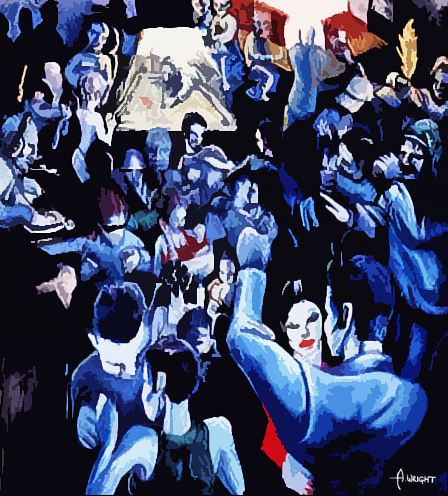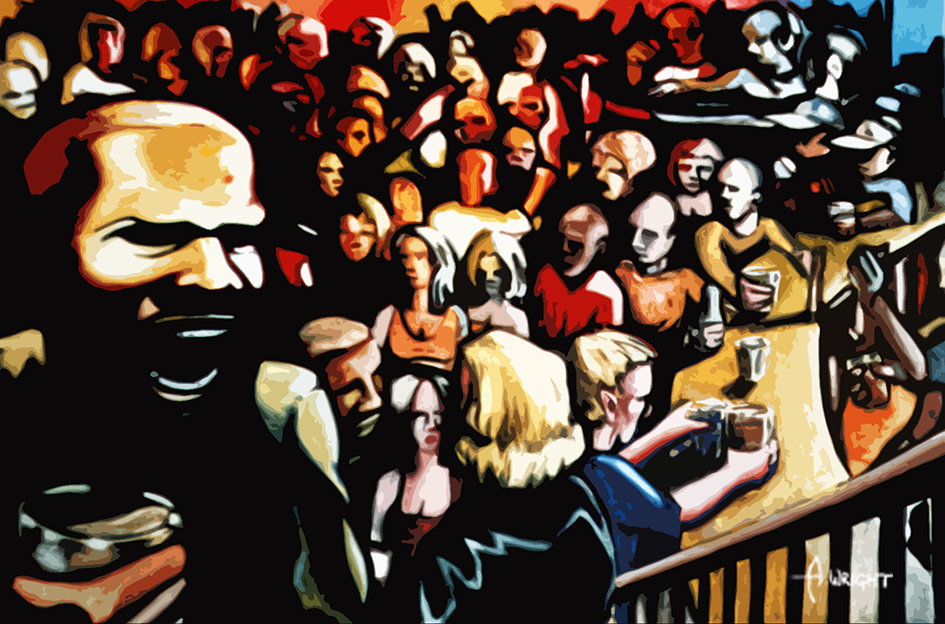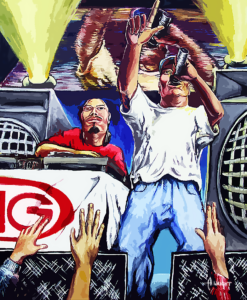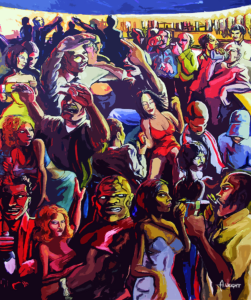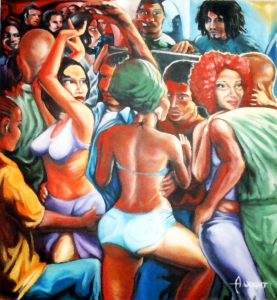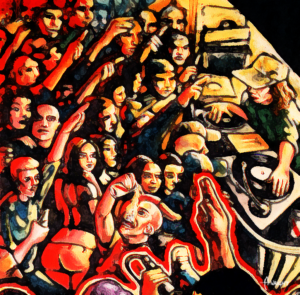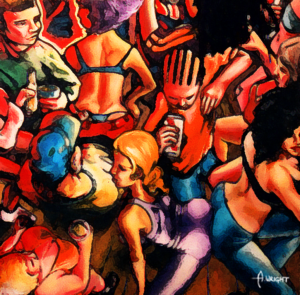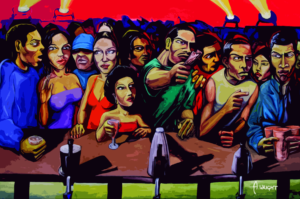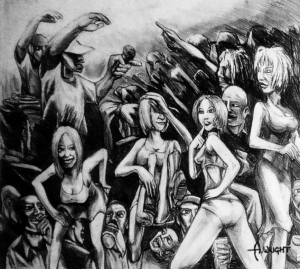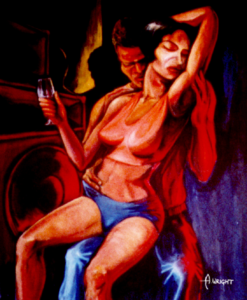This NFT collection by Andrew Wright (Nineoarts) is a collection of paintings produced between 1999 and 2002. These images represent the late 80s early 1990s where a vibrant and groundbreaking music scene emerged in the United Kingdom known as the Jungle rave scene. Taking root in cities like London, Brighton, Bristol and Nottingham, this cultural movement became a defining moment in the evolution of electronic music, paving the way for the birth of drum and bass.
These NFT images are heavily influenced by the Jungle rave scene of the early 90s. It was more than just music; it is a cultural movement that embodies the spirit of a generation. The scene was fueled by a sense of rebellion, social consciousness, and a desire for freedom of expression. It provided an outlet for young people to escape the pressures of society and connect with others who shared their love for music
Blues
A figurative acrylic on paper painting that depicts the allure of underground clubs hidden beneath the bustling city. Mysterious shadows and silhouettes embody the secretive and exclusive nature of these hidden gems.
Whats Your Name
‘Whats Your Name’ (2000) This acrylic painting by Andrew Wright captures the ecstatic release and uninhibited joy experienced on the dance floor. Vivid colours convey the intense emotions and freedom of self-expression felt in the club environment.
Oh My Gosh
Oh My Gosh A figurative oil painting by Andrew Wright that pays homage to the influential DJs of the era. The artist portrays their magnetic presence and the mesmerising connection they establish with the crowd through music.
Recreation
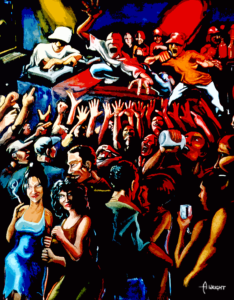
‘Recreation’ This oil painting by Andrew Wright portrays the rebellious and counter cultural energy of the late ’80s club scene. Figures engage in provocative gestures and exuberant dance moves, embodying the spirit of rebellion and freedom.
Recreation 2
‘Recreation 2’ This figurative oil painting by Andrew Wright showcases the diverse crowd that frequented the clubs of London and Midlands UK. A melting pot figures of different ethnicity’s and backgrounds come together, celebrating the unity and exclusivity of the club scene.
The Bomb
‘The Bomb’ by Andrew Wright. In this painting the artist employs a dreamlike quality in this oil painting, with blurred figures and hazy colors representing the euphoric haze of the club experience. Figures engage in exuberant dance moves and display provocative gestures.
The Bomb 2.1
‘The Bomb 2.1’ This is the top half of a 2 part painting by Andrew Wright. Bold strokes and vivid colors converge in this oil painting, representing the euphoria experienced on the dance floor. Andrew captures the synthetic experience, intertwining sound and visual elements.
The Bomb 2.2
‘The Bomb 2.2’ This vibrant oil painting by Andrew Wright portrays a crowded dance floor filled with people swaying to the pulsating beats of the era. Colors and lights merge into an electric display, capturing the energy and movement of the club scene.
The Bar
‘The Bar’ This oil painting by Andrew Wright captures the intimate moments and connections formed amidst the chaotic ambiance of the clubs. Figures engaged in hushed conversations and stolen glances evoke the allure of the night.
Look
‘Look’ A figurative drawing by Andrew Wright invites viewers to reminisce about the late ’80s club scene. The artist captures the nostalgia and fleeting moments, evoking a sense of longing and fondness for those bygone nights.
Bass
‘Bass’ This figurative oil painting by Andrew Wright captures the after-hours ambiance of the clubs. Figures whispering, entwined in conversation, or lost in their thoughts, highlight the intimacy and personal connections forged amidst the chaotic atmosphere.
The Jungle Scene: Revolutionising British Music
London: The Epicentre of Jungle Rave, with its diverse population and rich musical heritage, shaped the unique identity of the Jungle rave scene. Jungle music fused genres like reggae, dub, hip-hop, and breakbeat to create an infectious and innovative sound.
The Pulsating Heart of the Jungle Scene in London Underground clubs and warehouses in London served as hallowed grounds for Jungle rave enthusiasts. These spaces fostered unity and togetherness among people from diverse backgrounds.
Midlands: Pushing Boundaries in the Jungle Rave Scene Birmingham and Nottingham, in the UK’s Midlands region, played a significant role in the Jungle scene. The city’s underground parties and events pushed the genre’s boundaries, embracing rebellion and non-conformity.
Brighton: A Unique Take on Jungle Rave Brighton’s vibrant and bohemian atmosphere provided a backdrop for the fusion of music, art, and counterculture. Clubs like The Zap and The Event in Brighton showcased pioneering DJs and artists, pushing the Jungle genre further.
Impact Beyond the Clubs: Fashion, Art, and Youth Culture The Jungle scene influenced fashion, art, and youth culture, characterized by vibrant colors and distinctive styles. Its infectious energy and relentless beats propelled the genre into the mainstream and laid the foundation for drum and bass.
The Enduring Legacy of the Jungle Scene The Jungle rave scene, although evolving, remains deeply ingrained in electronic music history. It showcases the power of music to unite, break down barriers, and push creative boundaries.
Conclusion: A Transformative Period in British Music History London, Birmingham, Nottingham, and Brighton are forever associated with the Jungle scene. A revolution was born on the dance-floors, leaving an indelible mark on the world of music.

